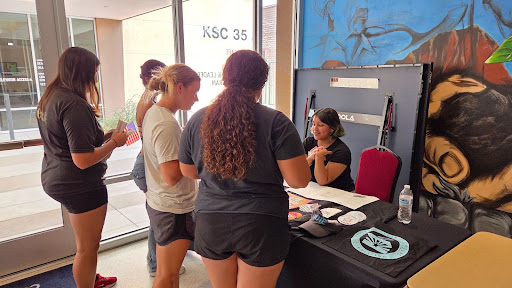Knowledge key in fight against skin cancer
Nikki Waldmann
Mesa Legend
 Not only is Arizona known for the desert and hot weather, but it is also one of the top-rated states in America for greater risk of skin cancer development. In 2014, the American Cancer Society estimated that Arizona would have over 1,400 new cases of skin cancer. Skin cancer most often develops on skin exposed to the sun, but can also occur on areas of skin not ordinarily exposed to sunlight, the Mayo Clinic explained. This means that arms, legs, and the face can develop skin cancer, as well as a person’s back, palms of the hands, or scalp even if they have a full head of hair.
Not only is Arizona known for the desert and hot weather, but it is also one of the top-rated states in America for greater risk of skin cancer development. In 2014, the American Cancer Society estimated that Arizona would have over 1,400 new cases of skin cancer. Skin cancer most often develops on skin exposed to the sun, but can also occur on areas of skin not ordinarily exposed to sunlight, the Mayo Clinic explained. This means that arms, legs, and the face can develop skin cancer, as well as a person’s back, palms of the hands, or scalp even if they have a full head of hair.
There are many different reasons one can develop skin cancer; family history being one of them. Morgan D. Davis, a current MCC/NAU CEP student on the local MCC SNA Council, and most recently voted SNAAz Board of Directors, states how much higher risk one could be for skin cancer if it is in one’s immediate family. “In individuals that are at high risk those who have familial hereditary links such as their mother, grandmother, uncle, siblings, someone in their family that suffered from this disease they are automatically at a higher risk,” Davis said.The other reason comes from too much exposure to UV rays, or excessive sun exposure.
Going tanning might make one feel better about themselves, or make a person look better, but in the long run, that person is only doing more damage to their skin. Tanning beds have been linked to skin cancer — the use of tanning beds excessively before age 40 holds a greater risk of developing skin cancer, especially in women. The best prevention methods are to always wear protective clothing, avoid tanning beds, and wear sunscreen during the day even when it’s cloudy. It’s most important, though, to have as much knowledge as possible. “I knew there were different types of skin cancer, but I didn’t know how many or what caused each one. I think people should know the basic precautions of preventing skin cancer and skin disease,” said ASU graduate Wesley Mota.
Davis cannot stress enough the importance of knowing the signs of possible development of skin cancer and how to prevent it. “The number one thing is knowledge, you need to inform yourself. You need to go to the doctor, and need annual physical assessments once a year where the dermatologist checking each area of your skin, and you need to know what is normal for you and what is not, you need to be your number one advocate for your health,” Davis said. There are three major types of skin cancer: basal cell carcinoma, squamous cell carcinoma, and melanoma.
Basal cell carcinoma is the most common form of skin cancer, affecting approximately 2 million Americans each year according to the University of Arizona Cancer Center. Squamous cell carcinoma is usually not life threatening, but if untreated it could spread to other parts of the body.
Melanoma is the most serious type of skin cancer. Melanoma develops in the cells that produce melanin which are the cells that give skin its pigment.
Melanoma can develop anywhere on the body and when melanoma is not taken care of or removed early on it could lead to possible death.
There are many treatment options such as freezing the cancerous cells, surgically removing it, or even chemotherapy for the worst cases of skin cancer. Successful treatment all depends on what the dermatologist suggests for each person and how extensive the cancer is. Skin cancer could appear in many different forms like a pearly waxy bump, or red with some discoloration.
Even something as simple as a mole could be cancerous. Normal moles are usually brown or black and have a smooth surface, but when melanoma occurs in the skin, the mole could then become bumpy and uneven.
The key for proper skin care is to make a visit to the dermatologist at least once to twice a year to ensure that the skin is in good condition, with no skin cancer that has developed over the past year.









